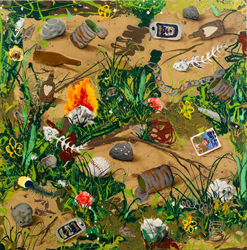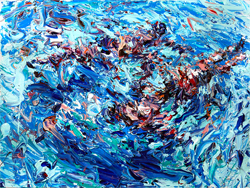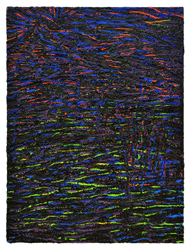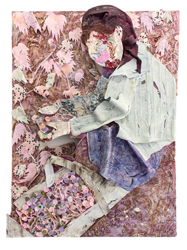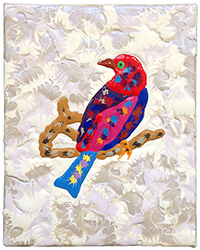Curated by Beth Parker
July 9 - August 20, 2016
Opening Reception: Saturday, July 9, 5-7PM
Q&A with Mark Posey, Roast Hoggmann, & Keenan Derby:
Saturday, July 30th, 11am
Closing Reception: Saturday, August 20, 6-8PM
Craig Krull Gallery is pleased to present Paint is a Thing, a group exhibition curated by Beth Parker. This exhibition showcases seven contemporary artists who use paint to create both an object and an illusionistic space. While these artists embrace the materiality of paint, they also depict images and narratives, allowing the paintings to become more than purely objects. Each piece incites a layered read, with a visceral reaction to the physicality of the surface, as well as a cerebral reaction to the illusion described.
Squeezing, weaving, and plopping, Caroline Larsen plays with paint until it is more than just the image that it’s describing. The cacti and succulents on front lawns coil like yarn, and the pointed leaves wave off the surface as though they are being blown by wind. Car crashes and sinking boats are depicted in paintings woven entirely of thick single pigments squeezed like frosting. The textile-like surface veils the tragedy so that we may focus on the paint application, such as a cadmium ember suspended in a night sky.
The characters in Roast Hoggmann’s paintings have one step in our world and one within that of the frame. Windows are glossy, jewelry is metallic, and frosting is matte. As he layers paint, he sculpts
and cuts it, adding and subtracting until each element finds its natural place in space. The vulnerable figures are built up until they seem almost touchable, inviting us to share in their humorous and sweetly sad predicaments.
Mark Posey pours acrylic onto panels, creating a hilly terrain that he then covers with oil and spray paint. Bouquets, tabletops, trash-strewn yards, precarious piles of stones; Posey applies a cubist perspective to each scene he paints. The wobbly subjects defiantly ignore conventional perspective and their thick edges catch the light, playfully reminding us that they are built on a flat picture plane.
Keenan Derby constructs his paintings with a mixture of acrylic and sand. Occasionally, he’ll add in a little metallic paint, so that the dark, sea-like surfaces glimmer. Each layer is contradicted by the next, to the point where the painting’s ripples really do seem to be on the surface of a deep abyss.
Riin Kaljurand collages dried layers of acrylic and household paint, which she has manipulated with traditional handcraft techniques such as basket weaving, knitting and crocheting. She uses these techniques to reference jobs that women were required to do in the former Estonian Soviet Socialist Republic, where Kaljurand was born. She questions this socially constructed idea of femininity, however, by then depicting women from Soviet Woman (a magazine from Soviet Estonia) working in traditionally masculine milieus like farms, factories, and construction sites.
Chrissy Angliker scoops and smoothes acrylic paint with the back of a spoon, creating pools that drip down rocky surfaces. The paintings are a marriage of form and function, as they are fluid in both brush marks and subject matter. Her energetic strokes, reminiscent of abstract expressionism, add movement to her paintings, so that the water swirls, and the flowers seem to be perpetually shrinking and growing.
With close inspection, Dominic Terlizzi’s painted images dissolve into a mosaic of cast acrylic objects. Some of these shapes are immediately recognizable- the pretzels, Goldfish, and looped ends of ribbons- and some are ambiguous blocks of color, or shapes that, an artist statement divulges, come from homemade bread. His paint marks are truly small things, “a found common object alphabet”, which are applied to a surface, serving to transform “minutia into grandeur.”
On view in the gallery office:


